

EOS 7D Noise
Whenever a new DSLR model is announce there's a 99% chance that it will have more pixels than earlier similar models - and the 7D is no exception.  With 18MP, it's currently (11/09) the highest pixel count APS-C sensor camera available. More pixels usually mean smaller pixels and smaller pixels can lead to higher noise, so the question is whether the increase in pixel count has resulted in higher noise (and lower image quality). Higher noise can always be suppressed by using stronger noise reduction algorithms, but stronger noise reduction results in lowered image quality, so digital noise reduction isn't a cure-all.
With 18MP, it's currently (11/09) the highest pixel count APS-C sensor camera available. More pixels usually mean smaller pixels and smaller pixels can lead to higher noise, so the question is whether the increase in pixel count has resulted in higher noise (and lower image quality). Higher noise can always be suppressed by using stronger noise reduction algorithms, but stronger noise reduction results in lowered image quality, so digital noise reduction isn't a cure-all.
You might think that a noise comparison would be easy. Just take a shot with a 7D and a another camera and see which has most noise. Sounds easy but in reality it's not quite that simple. For one thing, when printed at the same ppi (pixels per inch), the image from the 7D would be larger then those from, say, and EOS 40D. If printed at the same size, the 40D image would have to be upsized or the 7D image would have to be downsized - and downsizing can lower the noise level (by averaging pixels).
Then there is the fact that the 5D and 40D apply different degrees of default noise reduction to high ISO images. Even with high ISO noise reduction off there is still some default noise reduction applied to JPEGs, You can shoot RAW of course, and with RAW it is possible to turn all noise reduction off, but is that fair? Would you ever actually shoot at high ISO with no noise reduction applied? If you apply some noise reduction how much is resolution compromised? How much noise reduction can you apply to a 7D image before resolution drops lower than a 40D image - and so you need that much noise reduction for equal noise levels?
Below are a set of images showing noise at ISO 3200. These were shot as RAW images and converted to JPEGs using Canon's DPP software with the noise reduction turned off, set to the 40D default noise reduction and set to the EOS 7D default noise reduction. By "default" noise reduction I mean with noise reduction set to "standard". The EOS 40D images (top row) have been upsized by 133% to equalize the scale.
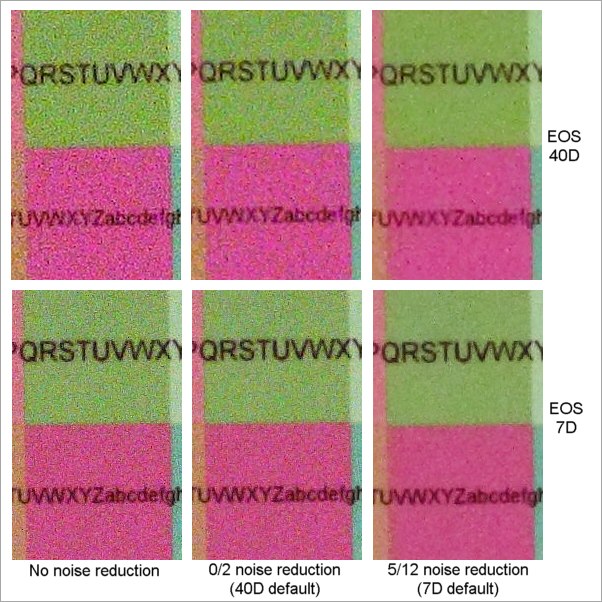
I think it's evident that the EOS 7D images show slightly lower noise and are "cleaner" than the 40D images. Canon seem to have done an excellent job in retaining low noise while decreasing pixel size and increasing resolution.
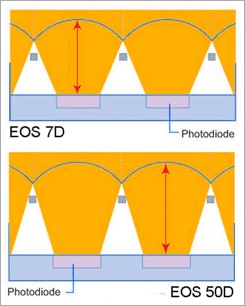 One way in which lower noise was accomplished was by using a new "gapless" microlens structure for the sensor to increase capture efficiency. The microlenses collect light from over the whole area of the sensor and each lens concentrates light onto the pixel well which contains the active area of the photodiode below.
One way in which lower noise was accomplished was by using a new "gapless" microlens structure for the sensor to increase capture efficiency. The microlenses collect light from over the whole area of the sensor and each lens concentrates light onto the pixel well which contains the active area of the photodiode below.
In addition Canon's fabrication process has been improved to achieve a higher conversion rate of light into signal and changes in microfabrication have enabled the gaps around the individual photodiodes to be reduced, allowing each photofiode to have a larger photosensitive area than was previously possible. All these changes combined have permitted a higher pixel density to be used with no increase in noise.
The sequence of images below show noise performance (with "standard" noise reduction) from ISO 100 to ISO 12800 (H).
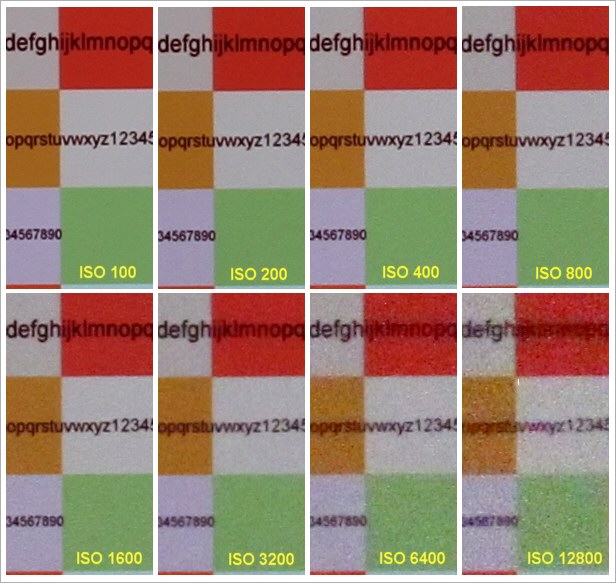
Noise at ISO settings of 100-800 show little noise. At ISO 1600 you can see some noise and there's a slight softening of detail which gets stronger at ISO 3200. However even at ISO 3200 image quality is very good as long as you don't want to make large prints. Image degradation at ISO 6400 is noticeable and ISO 12800 (H) is probably best left for use in emergency situations unless you only want small prints. However that's not to say it's not useful. The image below was shot at ISO 12800
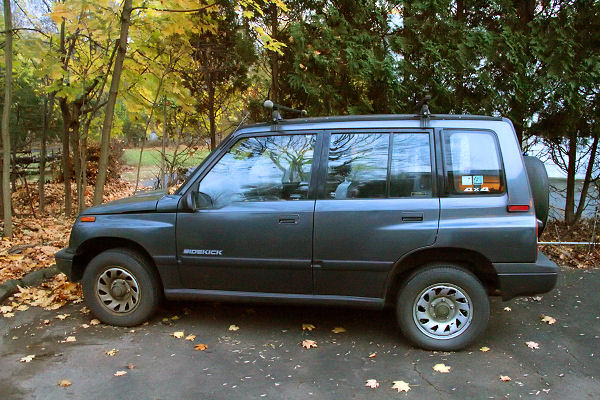
EOS 7D, EF-S 18-135is @18mm, 1/4s @f5, ISO 12800(H)
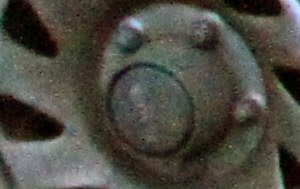 As you can see, the above image looks pretty good on the web, and would make a good small print. However if you look closely at the original full size image the noise is quite high as shown in the 100% crop from the original shown on the left.
As you can see, the above image looks pretty good on the web, and would make a good small print. However if you look closely at the original full size image the noise is quite high as shown in the 100% crop from the original shown on the left.
The image was shot in very dim light as you can tell from the exposure information. 1/4s at f5 and ISO 12800 means that there was barely enough light to focus. It was shot after sunset. The crop on the left is from a JPEG using the standard noise reduction setting. You can certainly see both luminance and chrominance noise and a blurring of detail due to the noise reduction algorithm. A 30x45 print wouldn't look very good but a 4x6 or 5x7 print would be just fine and you could probably even get a decent 8x10 with a little work.
Conclusions
The bottom line here is that for all practical purposes, the smaller pixels of the EOS 7D do not lead to higher noise levels than those of the EOS 40D and 50D in the final prints, and they do yield higher resolution images. Again, the differences will be most visible in large prints. If you are only printing small prints you may not see much of a difference between images shot with the EOS 7D and EOS 50D.
NEXT: Live View and Video
